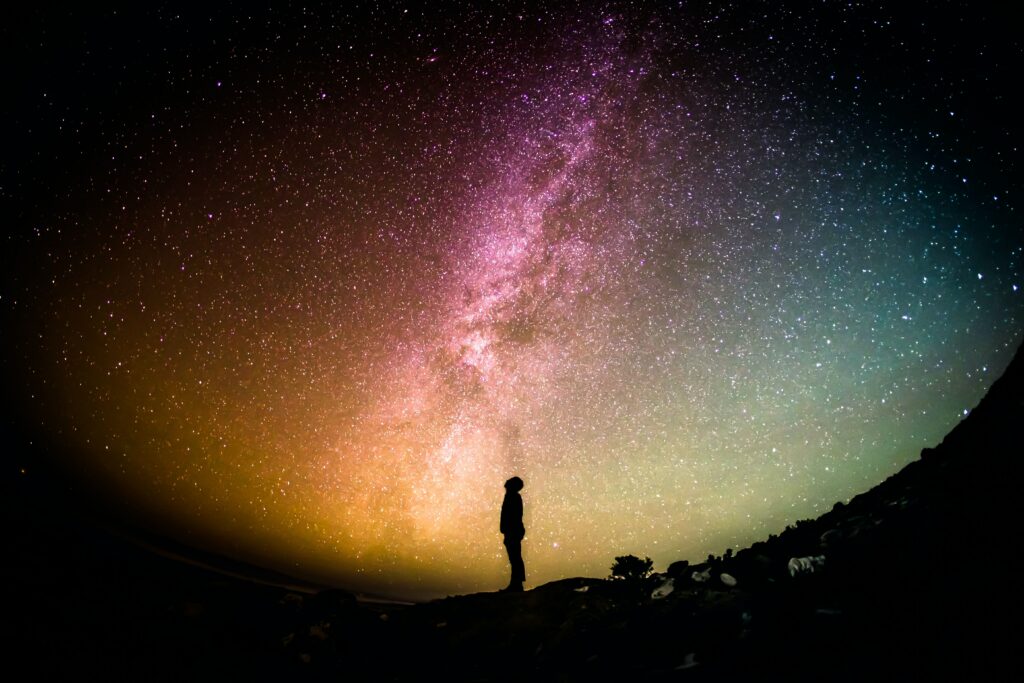
So what do we learn about the Creator by observing what he has created?
I’m not going to be picky about the order here—I suppose different people will notice different things at different times—but the one that jumps out at me first is power.
Whoever made this place must be really, really strong.
Philosophers note that effects have causes—that’s the basis for all science—and that the cause is typically greater—more comprehensive, more powerful, more something—than the effect.
Why do I start with strength? Because the cosmos is so big.
Unimaginably big.
The fastest any human being has ever traveled is just a hair under 25,000 mph. That was the crew of Apollo 10, returning to the earth from the moon. Now, suppose you start at the sun (I know, if you start at the sun you won’t get anywhere, because you’ll be incinerated. Work with me here.) and head outward at that speed.
- If my math is right, you’ll reach Mercury in 60 days.
- Venus in another 56.
- Earth in 39 more.
- Mars in 78 more.
By the way, this assumes that the planets are all lined up in a row, which they never are, and ignores Newtonian physics, which encourages rocket scientists to save fuel by using the gravitational forces of planets to accelerate a spacecraft by “slingshotting.” This means that your rockets will have to be firing all the time, and you could never carry that much fuel. But again, work with me.
So far this seems doable. But as you probably know, the distances start to increase outside Mars’s orbit.
- Jupiter is 576 days more. 800 total so far. That’s between 2 and 3 years.
- Saturn is another 700 days. Almost 2 additional years.
- Uranus another 1500.
- Neptune another 1650.
You’ve reached the edge of the solar system, in just 12 years and 9 months. And oh, my friend, you’re just getting started.
- The nearest star, Proxima Centauri, is another 115,333 years. I hope you brought a book.
- The nearest edge of our galaxy, the Milky Way, is another 670.5 million years.
- The nearest galaxy, Andromeda, is another 53 billion years.
- The edge of our “local” galaxy cluster is another 2.65 trillion years.
- The edge of the observed universe is another 131 trillion years.
Now, we’ll see in a bit what the James Webb Space Telescope shows us. If the Lord tarries, I expect we’ll keep developing technology that allows us to see deeper into space, using various frequencies. And I also suspect there will always be more—that we’ll never come to the “edge” of it—whatever that means.
The sheer scope of the cosmos tells us of the power of its Creator.
Consider a different aspect.
The sun, they tell us, is an average-to-mediocre star. Yet it’s an 800,000-mile diameter ball of raging nuclear fusion, with a core temperature of 16 million degrees. (That’s Kelvin, but with these numbers the scale you use doesn’t really matter.) It shoots out flaming geysers of gas 200,000 miles high for hours at a time.
And if you took the most powerful power plant on earth and duplicated it 2.5 billion times, and collected all the power that army of plants generated in a year, it would equal the output of the sun in just 1 second.
Yikes.
There are lots of other evidences of the Creator’s power. I’ve stood on the “hurricane deck” at the foot of Niagara Falls and been nearly knocked to my knees by the power of the falling water—and there’s a bigger waterfall right next door.
I’ve stood at the edge of Victoria Falls (“the smoke that thunders”) in Zambia and placed my finger in the water, knowing that the precipice stretches across the Zambezi River for more than a mile.
Apparently Isaiah gave some thought to this concept:
Hast thou not known? hast thou not heard, [that] the everlasting God, the LORD, the Creator of the ends of the earth, fainteth not, neither is weary? (Is 40.28).
You don’t need a Bible to know that whoever did all this is really, really strong.
Part 3: Omniscience | Part 4: TLC | Part 5: Closing Thoughts
